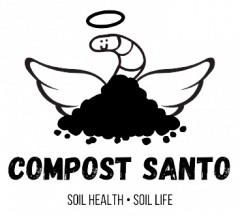Announcements
Worm Casting: Everything You Need to Know
In this blog post, we will do a deep dive into worm castings, nature’s most effective fertilizer.
What Are Worm Castings?
When we are talking about worm castings, we are talking about poop. Worm castings are considered to be the most valuable ingredient in vermicompost.
In some circles, the terms ‘vermicompost’ and the term ‘worm castings’ are often used interchangeably, though technically incorrectly. This is because even though vermicompost is likely to contain some percentage of undigested organic matter, it is generally mainly composed of worm castings – the digested portion. And because it is often tough (if not impossible) to differentiate between undigested and digested matter, the term ‘worm castings’ gets thrown around often.
How Are Worm Castings Made?
Worm castings are produced through a process known as vermicomposting which utilizes earthworms and microbes to consume and decompose organic waste producing a humus rich in organic matter, microorganisms, and worm castings.
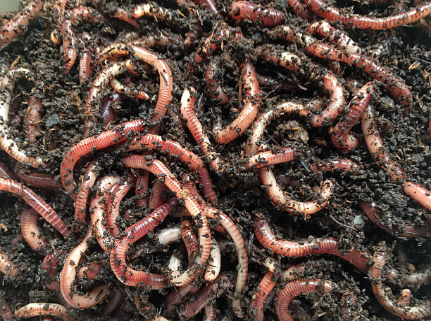
Worms are voracious feeders that can eat half their weight in waste daily. As organic matter is consumed, it travels the length of the digestive tract before being excreted as a bacteria and enzyme-enriched pill-shaped cast.
What Are the Benefits of Worm Castings in Plants and Soil?
Soil Benefits of Worm Castings
Increased Organic Matter
Organic matter should comprise 5% or more of healthy soil. Unfortunately, modern farming techniques, along with unpredictable harsh climate changes, have helped to deplete the soil of this precious resource, reducing that percentage to 1% or less in some cases. Often the results are devastating, leaving soils worm-free, and mostly lifeless.
Now you can feed the living, breathing ecosystem under your feet. The addition of worm castings provides soil with a boost of organic matter that also serves as a food source for bacteria, fungi, and other soil microbes. Adding compost, or other animal manure is an excellent way to increase organic matter in the soil.
Soil Structure and Water Retention
Did you know that a 1% increase in soil organic matter will allow a single acre of soil to hold an additional 25,000 gallons of water? Worm castings aid in soil aggregation, acting as a binder to help soil particles like sand, silt, and clay stick together creating a better space between them to help store water.
This increase in water retention can help decrease runoff, topsoil erosion, and algal blooms as nitrogen-rich synthetic fertilizers will remain in the soil rather than ending in our waterways.
Nutrient Delivery
Although nitrogen is abundant in the atmosphere and soil, it is not readily available in a form that plants can utilize.
The microbial life within vermicompost is incredibly effective at turning non-plant-available organic nitrogen compounds and oxidizing them into nitrite and nitrate, which are then released back into the soil in a plant-available form.
Plant Benefits of Worm Castings
Faster Germination
According to common belief, seeds should be able to grow using only their nutrients. However, research has proven that adding worm castings to the soil can enhance seed germination. It is recommended that no more than 20% of the seed-starting mix should consist of worm castings.
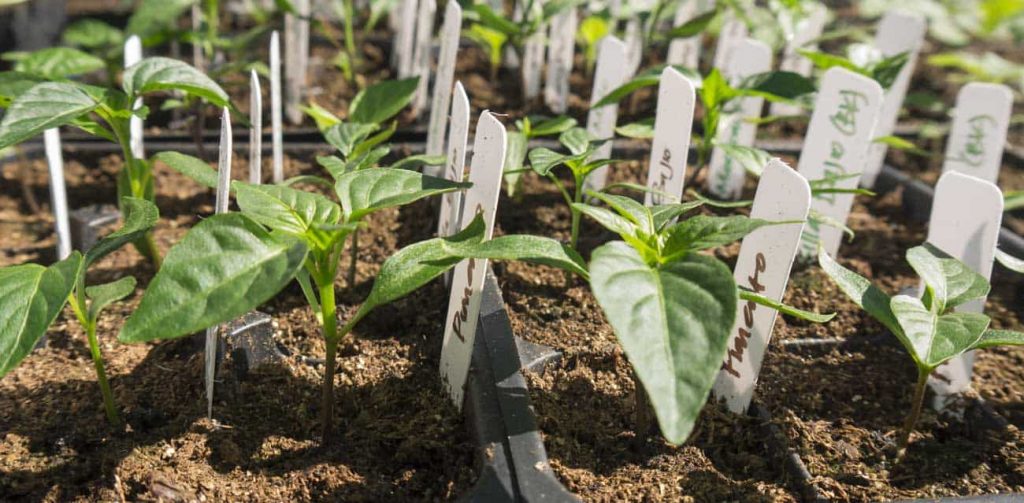
Quicker Seedling Growth
Studies have shown that using biologically-active vermicompost in the soil leads to faster seedling growth and quicker germination.
Strong Root Growth
Soil amended with vermicompost can greatly improve a plant’s root structure, enabling it to pump more nutrients and water. Roots become thicker and fan out further into the surrounding soil, ensuring better plant health.
Improved Pathogen Suppression
There are multiple ways in which worm castings can combat soil pathogens; in the case of Pythium, a common seedling-killing disease, vermicompost serves as a disguise.
Pythium is a type of parasitic oomycete that creates zoospores. These motile spores depend on the chemical signals plants release at the rhizosphere to locate and infect sprouting seedlings and established roots. However, adding vermicompost to the soil creates an obstacle that prevents Pythium zoospores from detecting these chemical signals.
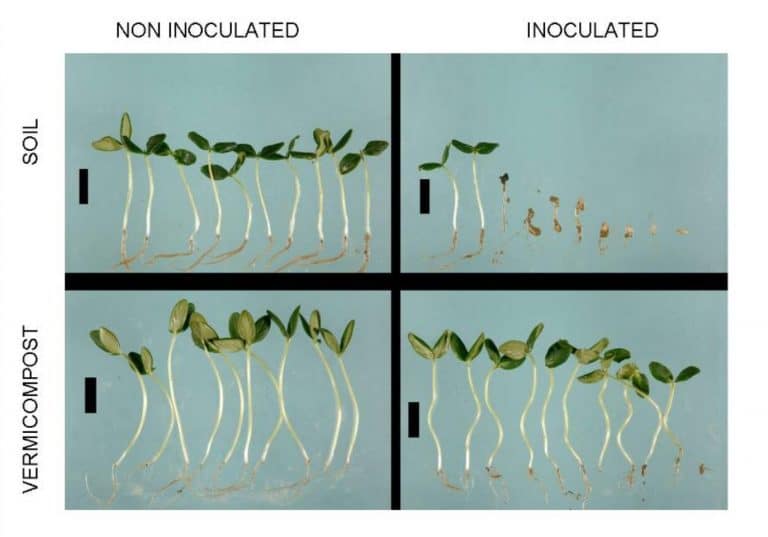
This image is from a study conducted by Cornell University. It displays four groups of cucumber seedlings. The left column shows the growth of seedlings not infected with Pythium. The difference in growth between soil and vermicompost is quite noticeable and significant.
Go worm poop!
Improved Pest Suppression
Adding vermicompost to soil can help repel pests such as aphids and mealy bugs, thanks to the presence of chitinase.
Chitinase is an enzyme found in certain vermicomposts that breaks down chitin, a glucose derivative that makes up the structure of insect exoskeletons.
Studies indicate that the application of vermicompost to soil can reduce pest attacks by 20-40%.
Higher Yield
Research on vermicompost mainly focuses on the increase in plant yield when soil is enriched with it.
The amount of available data can be overwhelming, especially considering the various plant species and organic materials used in vermicomposting. However, there is a direct correlation between the use of vermicompost and higher yields.
Better Pollination
Research indicates that bees pollinate plants grown in vermicompost-treated soil much more effectively. They take less time to discover the plants, visit them more frequently, and stay longer on each visit.
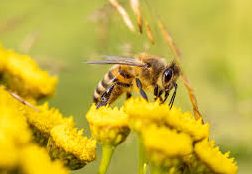
How to Apply Worm Castings to Your Garden
Adding worm poop to soil is a great way to improve its quality, but unlike synthetic fertilizers, there are no specific application rates that need to be followed.
Based on the academic literature we’ve reviewed, it appears that the majority of benefits are obtained when vermicompost constitutes approximately 10% of the medium. This means that if you have a 10-gallon planting medium, using 1 gallon of worm castings is typically sufficient. However, if you exceed application rates of 20%, you’ll hit a point of diminishing returns where additional worm castings will not provide significant benefits. Using more than 20% may even have negative effects on your plants’ growth, yield, and health.
The outcome greatly depends on the plant, its growth stage, and the quality of vermicompost utilized.
To help you with worm casting application rates, here are some helpful guidelines to follow!
Germinating Seeds
Did you know that most of the necessary elements for germination are already inside the seed itself? Studies suggest, however, that this process can be accelerated by using soil that has been treated with a small quantity of vermicompost.
For best results, only use a pinch of vermicompost on each seedling during the germination process.
Transplanting Seedlings
It is important to keep in mind that seedlings do not need a substantial amount of vermicompost when being transplanted into the garden. Simply incorporating 1-2 teaspoons of worm castings into each hole should suffice.
Transplanting Mature Plants
To reduce transplant stress and help roots establish more quickly, it is recommended to add approximately 1/2 to 1 cup of soil to the hole when transplanting mature plants.
Established Plants
To promote the best growth for your plants, add 1 to 2 cups of worm castings to an already established plant. You can also use 1/4 cup of castings for every 6-inch diameter of the growing area.
It is best to quickly incorporate worm castings into the soil rather than just leaving it on top. UV light is the top killer of microbes in vermicompost.
Lawn and Turf
There is a lot of variation in the recommended application rates of worm castings on lawns and turf. Some sources suggest using as much as one pound per square foot, while others advise a rate closer to one pound per 10 square feet.
If you’re looking for a more cost-effective option than directly applying worm castings to your turf grass, consider using a worm tea application. This method may be available in your area.
Worm Tea Application
If you want to save money and extend the use of your worm castings, consider making worm tea. It’s a simple and effective method.
To make actively-aerated compost tea (AACT), brew worm castings in a mesh bag suspended in water for 24-48 hours. This water is agitated to introduce oxygen to the system, supporting beneficial microorganism development.
Worm tea brewing usually involves the incorporation of alfalfa, kelp meal, or fish hydrolysate as a source of nourishment. Molasses is a widely used additive, but be aware that it can cause a temporary spike followed by a decrease in microbe activity.
You can use worm tea as a foliar spray or root drench, but it’s best to use actively-aerated tea within a few hours after brewing.
Judging Quality in Worm Castings
The quality of the product can vary greatly when it comes to worm castings. Unfortunately, it’s difficult to determine the quality without the use of a microscope or expensive tests. This means that not all worm castings are the same and it’s important to be aware of this when making a purchase.
That said, here are some helpful guidelines to consider:
Nutrient Values
Nitrogen, phosphorous, and potassium (NPK) ratios unequivocally determine the nutrient levels found in conventional fertilizers. This measure, however, is useless when judging vermicompost, which will usually have a 1-0-0 NPK value. Check commercially bagged worm castings, and you are likely to see this number.
A notable difference between worm castings and conventional fertilizers is that fertilizers directly nourish plants. Worm castings, on the other hand, enhance the quality of the soil.
Presence of Plant Growth Hormones
Did you know that some types of vermicompost contain plant growth hormones that can significantly improve plant growth, root growth, and yield? These hormones are usually classified as auxin, gibberellin, cytokinin, and abscisic acid, and academic research is constantly making progress in identifying them.
This article doesn’t delve too deeply into plant growth hormones, as it is not within the scope of this post. For a better understanding of the descriptions and functions of these hormones check out this awesome resource from Untamed Science.
Humic Acid Levels
Humic acids play a vital role in providing nutrients and water to plants, as well as promoting plant health in the absence of fungal relationships in the root zone.
The positively charged humic acids are drawn towards the negatively charged roots, which helps the plant to absorb nutrients more efficiently.
Moisture Content
To ensure the best quality, it’s recommended to buy worm castings that have a moisture content between 55-70%. Worm castings that sit for very long tend to dry out. When moisture levels get too low, it can make the castings hydrophobic making it difficult for the castings to retain water.
Color
This may be somewhat subjective, however, as a general rule of thumb, a dark brown ‘cocoa’ color is preferable over black. Black worm castings (or compost, for that matter) indicate anaerobic conditions were reached during the composting process.
Granularity
It’s essential to understand that the quality of worm castings cannot be judged based on their shape alone. Quality castings may have different shapes and textures.
Red wigglers produce elongated and irregularly shaped casts that are stickier. On the other hand, African nightcrawlers produce rounded and granular casts that are moist and can seem to flow from your hands like sand.
Buying Worm Castings in Small Quantities
Garden Centers/Big Box Stores
You can buy worm castings from gardening centers or big box hardware stores, but they usually come in unbreathable plastic bags and may have been harvested months ago, which would reduce or kill the helpful microbes inside.
The castings are expected to be uniform, but there is a possibility that they may have a consistently poor quality.
Online Sellers
More and more small-scale producers are now offering worm castings for sale on the Internet. However, the consistency and quality of these products can vary greatly. Nonetheless, the worm castings sold by smaller online sellers will likely have been harvested more recently than those found in large garden centers.
Conclusion: Worm Castings Are Not a Commodity – Quality Matters
Considering worm castings as a commodity does more harm than good. It adversely affects small-scale worm casting producers who create high-quality and biologically active vermicompost and struggle to compete with larger companies selling old products in plastic bags.
Worm castings can be highly variable in texture, color, particle size, and properties such as microbiology, which cannot be seen with the naked eye. These variabilities may have a big impact on how well they perform in your garden, depending on the different methods of application, plant species, and stages of growth.
Ask a vendor to produce test results whenever possible. And if you are a seller of worm castings, test your castings through your local extension office or a reputable laboratory.
Whatever your interest in worm castings, whether it’s to consume or produce, we wish you the best of luck!
Sold Out!
Buying Compost during Winter
Change Is Coming In 2021
Compost Back In Stock! – Limited
We have a limited amount of product back on sale! Please make sure to contact us as soon as possible if you are interested. Product sells fast!!!
Cheers!
More Compost is coming!
We are sold out compost, however, MORE IS COMING!
We currently have over 100 yards going through the curing process, and expect to have more compost ready for sale towards the end of October.
STAY TUNED!!
Bulk Unsifted Compost – Sold Out!
Hi folks! We are now officially sold out of our bulk unsifted compost. Cubic foot bags of sifted compost are available, however. We also have mixed bags of compost with worm castings, as well as just worm castings for sale.
If you are interested, make sure to contact us as soon as possible. Thank you!
